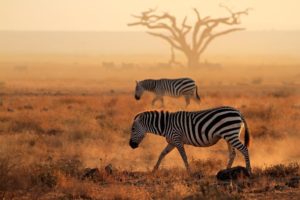Meru National Park, where George and Joy Adamson released their most famous lioness, Elsa, back into the wild (a story immortalised in the book and film Born Free), is increasingly re-appearing on safari itineraries. After it was founded in 1966, the park, run by one of Kenya’s most energetic wardens, Peter Jenkins, was a popular destination for safaris. Then, championed by the International Fund for Animal Welfare, with the support of the EU, the park became a KWS cause célèbre and was comprehensively restored, with newly cut earth roads, a dedicated force of rangers led by a new warden (Peter Jenkins’ son Mark Jenkins), and a poacher-proof rhino sanctuary near the main gate which is home to both white and black rhinos.
Safaris in Meru National Park
Meru is has unspoiled 870km² stretch of well-watered, dense bush, acacia woodland and verdant, tall grasslands spiked with weird-looking doum palms is ripe for discovery. It has game viewing which now easily matches or exceeds the sort of safari experience you’ll have in popular parks such as Tsavo West or Tsavo East, with increasingly frequent sightings of all the ‘Big Five’, plus cheetah and numerous other savannah species. And its handful of camps and lodges includes the exceptionally beautiful Elsa’s Kopje and two boutique, riverside safari camps (both with swimming pools) – Rhino River Camp and Offbeat Meru.
Meru’s numerous streams and rivers are a characteristic feature of the landscape. The Rojewero viewpoint and boardwalk – a lovely spot to stretch your legs and take in the dense riverine forest. There are good hippo, croc and fish-eagle-spotting opportunities in the area. Driving around Meru National Park through the thick bush, you’re also likely to have close encounters with some of the park’s huge herds of buffalo – the key prey for Meru’s lion prides.
As well as morning and evening game drives, if you’re in Meru National Park for several days, you might want to include a full-day drive down to the south of the park. The grave of Elsa the lioness is out in this remote area on the north bank of the Ura River, a major tributary that forms the parks’ southwest boundary.
Flora and fauna of Meru National Park
Much of Meru is flat or gently undulating and huge areas are thickly covered in a base of tall grass savanna. As the dry season sets in, the grass is steadily grazed and it dries up and dies back, allowing much better visibility. Along the watercourses, acacia woodland provides a jungle-like environment and oddly shaped doum palms and venerable baobabs are scattered across the horizon. Coupled with the very low numbers of visitors in the park at any one time, this memorable landscape and its increasingly abundant wildlife make for a compelling combination.
On our visits to Meru in recent years, we’ve had good luck with predator sightings, including lions and cheetahs, and we rate the overall wildlife-viewing here highly. The characteristic northern varieties of plains mammals are easily seen – magnificent reticulated giraffe, fine-striped Grevy’s zebra, dapper Beisa oryx, skittish and beautifully marked lesser kudu and the distinctively long-necked browsing gerenuk gazelle. You’ll also see Grant’s gazelles and some of the biggest herds of buffalo you’ll encounter anywhere in Kenya, as well as good numbers of elephants. All the mammals thrive because of Meru’s abundant water, and in many of the streams and rivers you can see crocodiles, freshwater turtles and hippos.
Birdlife in Meru National Park is stunning from ostriches and the smartly plumaged vulturine guineafowl that you’ll see as you drive around, look out for red-necked falcons, which nest in the stands of doum palms, and after dark the remarkable Pel’s fishing owl, a rare and very large owl with a wingspan of around 1.5m. You’re most likely to identify by its unusual call – a deep, horn-like note, audible for a couple of kilometres. Characteristic of the streams is the African finfoot (much sought-after by birdwatchers), though these are hard to see from the banks, and you’ll probably have more luck with kingfishers, including the ubiquitous pied and more elusive giant kingfisher. The forested areas along the watercourses are also good for specialist flower-feeding sunbirds, including the smaller black-bellied sunbird that feeds on parasitic Loranthus flowers growing in riverbank acacias. If you’re a keen birder, you’ll also want to spot some of the park’s four species of honey guides – and you won’t need reminding to look out for flocks of gloriously coloured golden-breasted starlings, for which Meru National Park is a stronghold.




